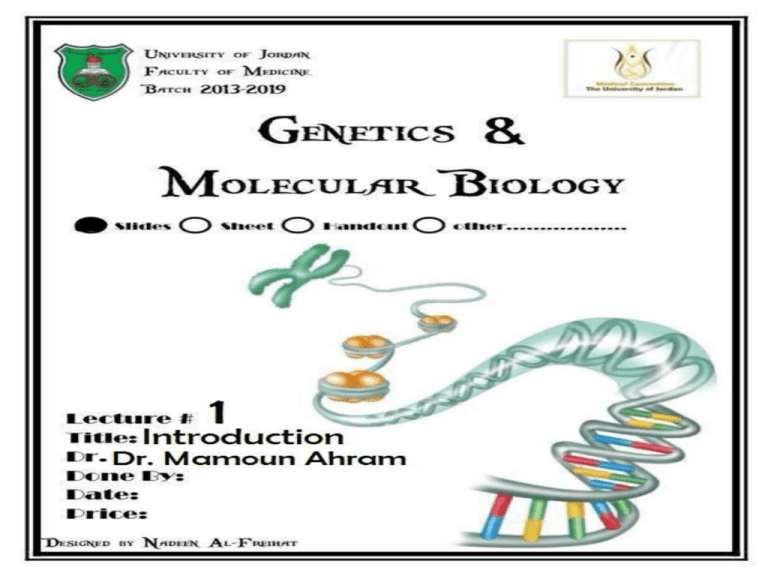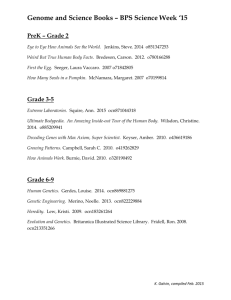Lecture 1: Introduction Principles of Genetics and Molecular Biology
advertisement

Lecture 1: Introduction Dr. Mamoun Ahram Faculty of Medicine Second year, Second semester, 2014-2014 Principles of Genetics and Molecular Biology Syllabus and references Part I: Cell biology (Dr. Mamoun Ahram) The Cell: A Molecular Approach, Geoffrey M. Cooper and Robert E. Hausmann, 6th edition, Sinauer Associates, 2013. Part II: Molecular biology (Prof. Said Ismail) Mark's Basic Medical Biochemistry, Smith, Marks and Lieberman, Lippincott, Williams and Wilkins, 2009. Part III: Genetics (Prof. Mohammad El-Khateeb Emery's Elements of Medical Genetics, Muller & Young, Churchil Livingstone, 13th edition, 2011. The origin of life DNA homology Humans and others “We are all Arabs”!! Arabia was indeed the first staging post in the spread of modern humans around the world. The American Journal of Human Genetics 90, 1–9, February 10, 2012 Genetic relatedness of world populations Cavalli-sforza et al., 1988 Hum Immunol. 2001 Sep;62(9):901-9. 9 “Dr. Ahram 12 Prokaryotic cells (E. coli) Simple, rapid growth, small genome. They are ideal models to study basics of biochemistry and molecular biology. E. coli is used to understand basic mechanisms of molecular genetics. It has ~4.6m base pairs/4300 genes/1 chromosome. They cannot be used to study aspects of eukaryotic cell structure and function. Yeast The simplest eukaryotes with features of eukaryotic cells. A distinct nucleus surrounded by a nuclear membrane A cytoskeleton and subcellular organelles Growth is rapid and as colonies. 12 million base pairs of DNA/6000 genes/ 16 chromosomes Used to understand DNA replication, transcription, RNA processing, protein sorting, and regulation of cell division. Dictyostelium discoideum A cellular slime mold More complex genome than yeast’s, but simpler than that of higher eukaryotes’. can be readily grown in the laboratory and undergo genetic manipulations Highly mobile cells used to study molecular mechanisms of animal cell movements. Single cells can aggregate into multicellular structures Caenorhabditis elegans More complex eukaryotes 97m base pairs of DNA/~19,000 genes/6 chromosomes easily grown in lab and genetically manipulated Adult worms consist of only 959 somatic cells starting from 1090. used for studies of animal development and cell differentiation and apoptosis Drosophila melanogaster (The fruit fly) 180m base pairs, four chromosomes, 14,000 genes Easily maintained and bred in the laboratory with short reproductive cycle (~2 weeks) • unravel genes involved in development and differentiation • Determine the relationship between genes and chromosomes Xenopus laevis (a frog) used in studies of early vertebrate development. Xenopus eggs are large (a diameter of ~ 1 mm) and develop outside of the mother stages of development can be studied in the laboratory. Used in studying development, differentiation, and embryonic cell division. Mice 3000m base pairs, 20,00025,000 genes/20 chromosomes Transgenic mice with specific mutant genes introduced into the mouse germ line Cultured mammalian cells Mammalian cells are isolated, get immortalized, and grown in dishes can be manipulated under controlled laboratory conditions. Uses: many aspects of mammalian cell biology, (DNA replication, gene expression, protein synthesis and processing, and cell division, etc.) Viruses intracellular parasites They reproduce by infecting host cells and taking over the cellular machinery. In their simplest forms, viruses consist of genomic nucleic acid surrounded by a protein coat. Bacteriophages (bacterial viruses) allowed understanding basic molecular genetics. Organelles





